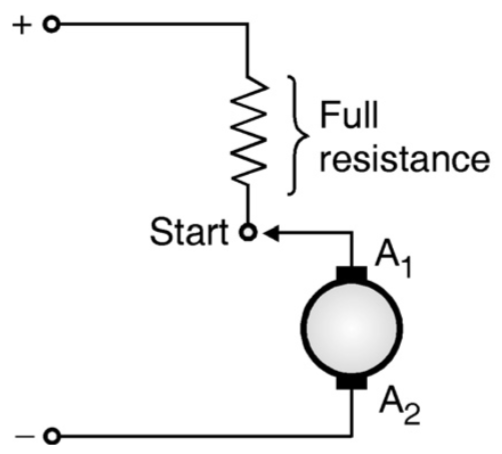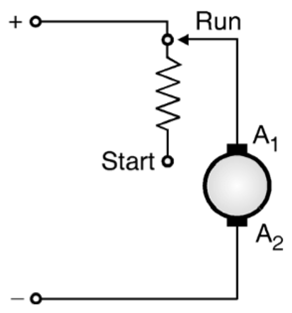DC Motor Starter is an additional external device which is required to be connected along with a dc motor, in order to start the motor in a safe manner. That means starting a dc motor without a starter is not safe for the motor. So we should understand the need of starter (Fig. 1).

Fig. 1:DC Motor with Starter
Need of a DC Motor Starter
We know that for a dc shunt motor,
\[\text{V = }{{\text{E}}_{\text{b}}}\text{+ }{{\text{I}}_{\text{a}}}{{\text{R}}_{\text{a}}}\]
And for a dc series motor,
\[\text{V = }{{\text{E}}_{\text{b}}}\text{+ }{{\text{I}}_{\text{a}}}\left( {{\text{R}}_{\text{a}}}\text{+ }{{\text{R}}_{\text{s}}} \right)\]
Hence the expression for Ia are as follows:
For dc shunt motor,
\[\]\[{{\text{I}}_{\text{a}}}=\text{ }\frac{\text{V – }{{\text{E}}_{\text{b}}}}{{{\text{R}}_{\text{a}}}}\]
For dc shunt motor,
\[{{\text{I}}_{\text{a}}}=\text{ }\frac{\text{V – }{{\text{E}}_{\text{b}}}}{\left( {{\text{R}}_{\text{a}}}\text{+ }{{\text{R}}_{\text{s}}} \right)}\]
At the time of starting the motor, speed N = 0 and hence the back emf Eb = 0. Hence the armature current at the time of starting is given by,
For a dc shunt motor,
\[{{\text{I}}_{\text{a (starting)}}}=\text{ }\frac{\text{V}}{{{\text{R}}_{\text{a}}}}\]
For a dc series motor,
\[{{\text{I}}_{\text{a (starting)}}}=\text{ }\frac{\text{V}}{\left( {{\text{R}}_{\text{a}}}\text{+ }{{\text{R}}_{\text{s}}} \right)}\] -.- dc series motor
Since the values of Ra and Rs are small, the starting currents will extremely large if the rated voltage V is applied to the motor at the time of starting. The starting current of the motor can be 15 to 20 times higher than the lull load current. Such a high starting current has the following undesirable effects.
Effects of high starting current
Due to very high starting current, the supply voltage will fluctuate. The fluctuations in supply voltage affects the other equipments operating on the same supply. Due to excessive current, the insulation of the armature winding may get damaged. The fuses will blow, circuit breakers will trip. For dc series motors the torque is
\[\text{T}\propto \text{I}_{\text{a}}^{\text{2}}\]
So an excessively large starting torque is produced. This can put a heavy mechanical stress on the winding and shaft of the motor resulting in mechanical damage to the motor. So in order to avoid all these effects we have to keep the starting current of the motor below the sale limits. This is so in order to avoid all these effects we have to keep the starting current of the motor below the safe limits. This is achieved by using a starter.
Working Principle of DC Motor Starter
DC Motor Starter is basically a resistance which is connected in series with the armature winding only at the time of starting the motor. Its job is to limit the starting current of the motor. The starter or starter resistance will remain in the circuit of the motor only at the time of starting and will go out of circuit or becomes ineffective when the motor speed reaches its desired value. The starter principle is illustrated in Fig. 1. At the time of starting. the starter is in the “start” position as shown in Fig. 2. So the full starter resistance appears in series with the armature. This will reduce the armature current of the motor at the instant of starting. The starter resistance is then gradually cutoff by moving it towards run position. The motor will speed up, back emf will be developed and it will regulate the armature current. The starter is not necessary then. So the starter is pushed to the “Run” position as shown in Fig. 3 under the normal operating condition. The value of starter resistance is zero in this position and it does not affect the normal operation.

Fig. 2: At the time of starting

Fig. 3: Under normal operating condition
Types of DC Motor Starter
There are two types of starters used for the DC shunt motors:
- Three point starter.
- Four point starter.
In addition to this a two point starter is used for DC series motor starting.